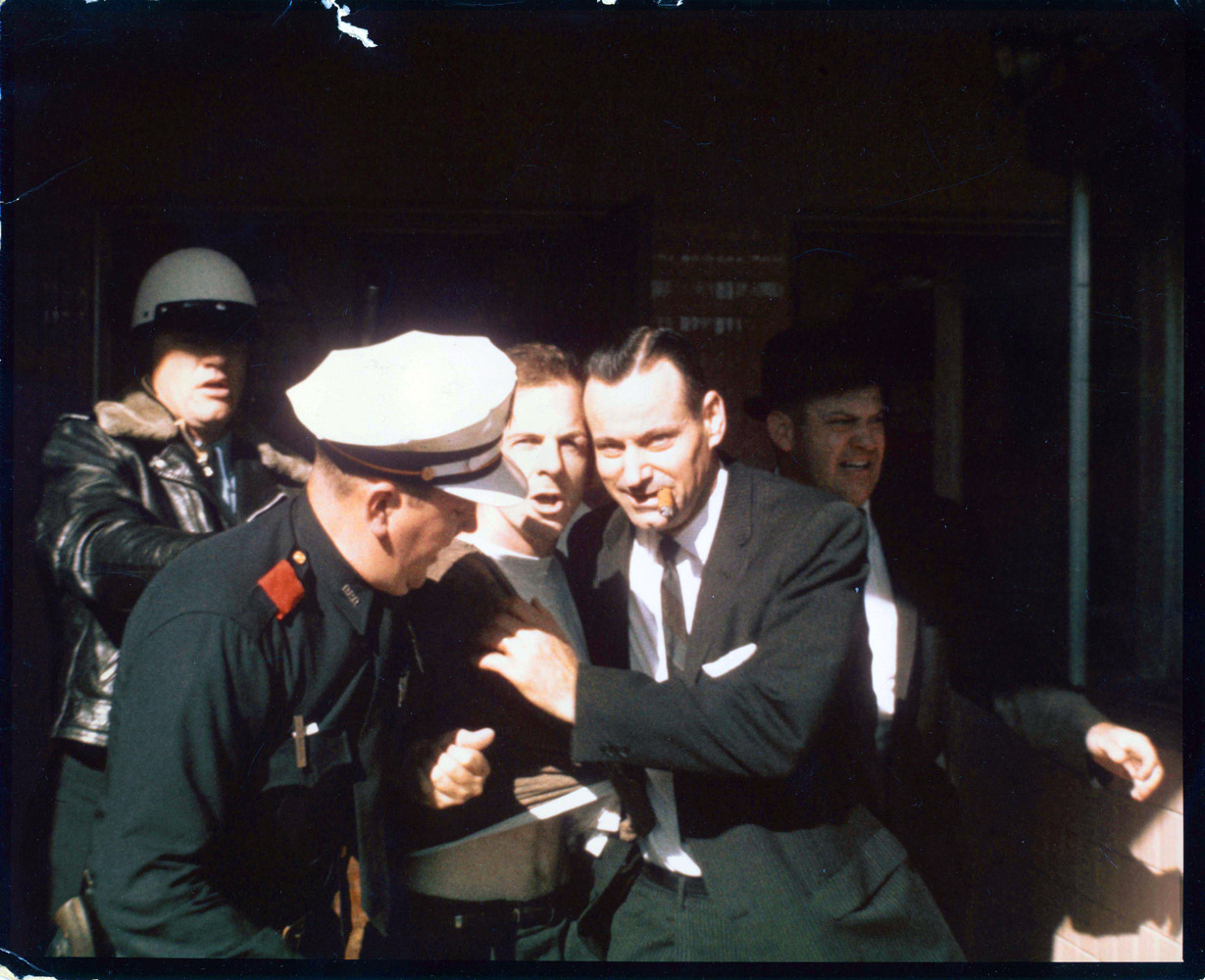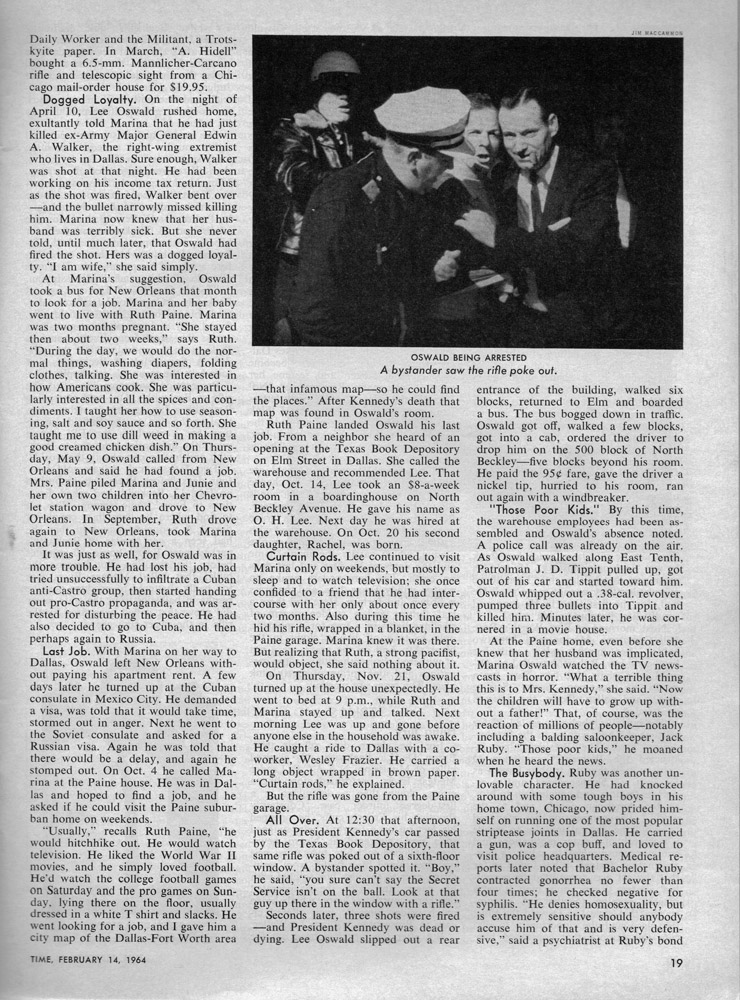
In our 50th anniversary commemorative issue of TIME, we published a rare photograph of Lee Harvey Oswald being arrested outside the Texas Theatre. Gary Mack, the curator of the Sixth Floor Museum at Dealey Plaza, writes for LightBox about the photo’s legacy:
Certain images and scenes from the Kennedy assassination — the gruesome Abraham Zapruder film; Bob Jackson’s shocking photo of Jack Ruby shooting Lee Harvey Oswald; Stan Stearns’ heart-wrenching view of John F. Kennedy Jr. saluting his father’s casket outside the Cathedral of St. Matthew — remain as powerful and disturbing today as they were 50 years ago.
But there’s another photograph that remains relevant and gripping five decades later, in a different way, and relatively few have seen it. The picture was taken by Dallas freelance photographer James “Jim” MacCammon barely 80 minutes after gunshots reverberated through Dealey Plaza. MacCammon photographed 24-year-old Oswald as he emerged from the Texas Theatre into the bright midday sun, sandwiched between Patrolman C.T. Walker and, still chewing his cigar, Detective Paul Bentley.
Although MacCammon contacted news agencies, including LIFE, his remarkable photo went unpublished until TIME ran it three months later in February 1964. Internal records show that Time Inc. shared that picture and others MacCammon made with the FBI. Eventually, in late 1964, three MacCammon photographs appeared in volume 20 of the Warren Commission’s documentation.
“It was always like a lecture,” remembers Mary MacCammon, the photographer’s daughter, who was in the 4th grade at the time. “He always wanted us to know the story of what happened when Oswald was arrested.”
The MacCammon photo of Kennedy’s assassin essentially disappeared for more than 40 years, until the New York Times included it in Detective Bentley’s obituary on July 27, 2008. The photo credit line read, Jim MacCammon, courtesy of Howard Upchurch.
But this time, unlike when TIME ran the photo in 1964, the picture appeared in color. Howard Upchurch, a Dallas-area Kennedy assassination researcher, had befriended a man who in 1963 worked at MacCammon’s favorite Dallas photo lab and kept a color print of the MacCammon picture. Years later he gave it to Upchurch, who showed it to me in the 1980s and later loaned it to The Sixth Floor Museum at Dealey Plaza.
MacCammon, who died in 2005, captured a moment that says so much about the soon-to-be-accused assassin and why so many still do not believe Oswald was the sole killer of President Kennedy and the killer of Dallas Police officer J.D. Tippit.
As reported at the time, when police led him out of the theater, Oswald shouted: I protest this police brutality and I am not resisting arrest!
Oh? Moments earlier, as cops approached him, Oswald suddenly punched Officer Nick McDonald in the face, drew a revolver from his waistband and tried to shoot him. McDonald jammed his hand on the gun and prevented it from firing as other officers pummeled Oswald to the floor, sat him in a seat and cuffed him. (MacCammon took a picture of that moment, too, but the image is too dark to reveal much.) [Ed’s note: The TIME-LIFE Picture Collection discovered several duplicate negatives in our search for MacCammon’s photographs. We’ve reproduced one of them below.]
Do innocent people take guns to the movies, assault a police officer and try to shoot him? Does an innocent person start a fight with an armed policeman, then act surprised and angry when the policeman and others defend one of their own?
Such is the enigma of Lee Harvey Oswald, who spent the last 48 hours of his life denying he had shot anyone rather than taking credit for removing a president and a cop — two fathers cut down in their prime. Did he or didn’t he change history that day in Dallas, and doesn’t that one photograph graphically illustrate why so many remain unsure about the events that unfolded that day?
And now, as MacCammon heirs, who’ve only known about but do not possess his images, learn about and recover their father’s unique documentation of the Kennedy assassination, we wonder what other revealing images are still awaiting discovery in someone’s closet or scrapbook.
Gary Mack is the Curator at the Sixth Floor Museum at Dealey Plaza in Dallas.
Additional reporting by Vaughn Wallace.


More Must-Reads from TIME
- Donald Trump Is TIME's 2024 Person of the Year
- Why We Chose Trump as Person of the Year
- Is Intermittent Fasting Good or Bad for You?
- The 100 Must-Read Books of 2024
- The 20 Best Christmas TV Episodes
- Column: If Optimism Feels Ridiculous Now, Try Hope
- The Future of Climate Action Is Trade Policy
- Merle Bombardieri Is Helping People Make the Baby Decision
Contact us at letters@time.com